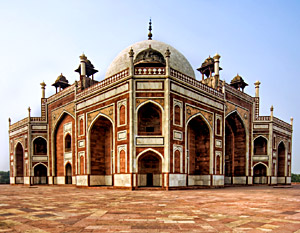Art and architecture received handsome patronage under the reign of Mughal emperor, Akbar. Though he was not a prolific builder but he did commission some of the most impressive Mughal monuments in India. The main contribution of Akbar in the field of architecture and sculpture can be witnessed in the form of the Fatehpur Sikri.
 One of the main features of architecture and sculpture during Akbar era is the wide use of sandstone as the building material. As far as the architectural elements are concerned, these have been inspired from the Mughal architecture. Arches, domes, pillars, chhatris, chhajjas and jharokhas have been utilized to build the Fatehpur Sikri and the Agra fort. The latter, though commissioned by Akbar, was finally completed during the rule of Shah Jahan.
One of the main features of architecture and sculpture during Akbar era is the wide use of sandstone as the building material. As far as the architectural elements are concerned, these have been inspired from the Mughal architecture. Arches, domes, pillars, chhatris, chhajjas and jharokhas have been utilized to build the Fatehpur Sikri and the Agra fort. The latter, though commissioned by Akbar, was finally completed during the rule of Shah Jahan.
Another important monument built by Akbar is the tomb of Humayun. The sculpture of Humayun`s Tomb is quite simple yet the splendor of the building is evident. The sculptures during Akbar era comprise intricate inlay works. The sculpture of Fatehpur Sikri is a living example of the Mughal sculpture and architecture that evolved during this period. The same idiom was followed by the later Mughal emperors including Jahangir and Shah Jahan.



















